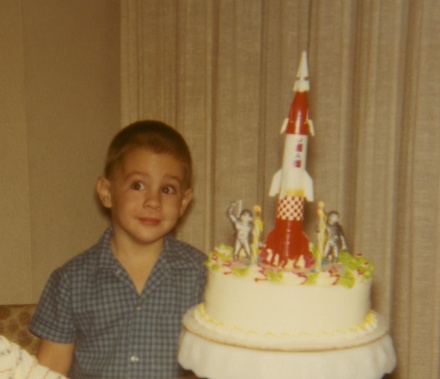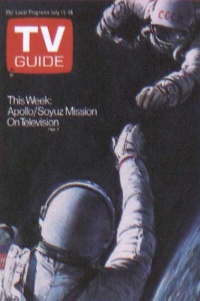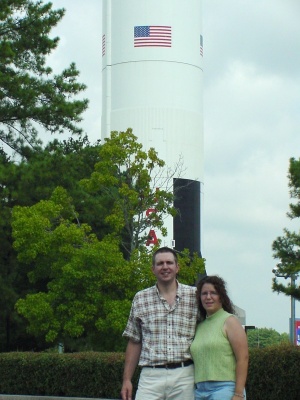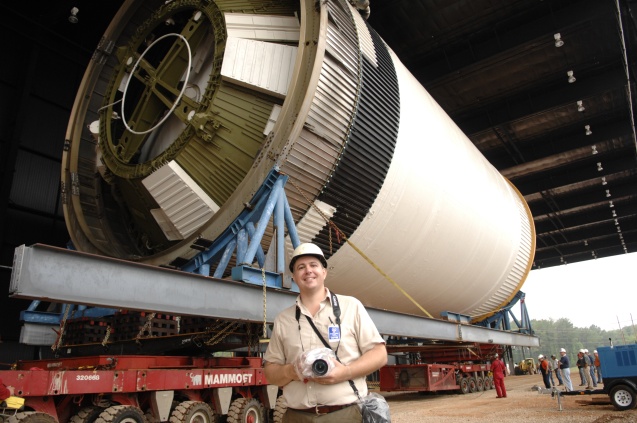About: Me | The heroicrelics.org Logo | This Site | Citations | Site Contributors
About Me
I'm Mike Jetzer. I was born 20 days after the first Saturn V launch (the launch was November 9, 1967, for those of you not up on such things), and I've been a 1960s Space Race nut nearly all of my life.
 Now, being born in late 1967 means that
there's little of the Space Race which I remember first-hand, but
there are bits and pieces which I do remember.
Now, being born in late 1967 means that
there's little of the Space Race which I remember first-hand, but
there are bits and pieces which I do remember.
I remember the cake from my fourth birthday, or more precisely, the rocket on that cake. The cool thing about this rocket was that the white tip of the rocket would shoot off (or "jettison", to use my grown-up words) if you squeezed the white fins on the red stage just below that. I also remember how sad I felt when the toy was inevitably stressed beyond its design specifications by an overzealous four-year-old.
I remember being excited when my parents told me I could stay up for a rocket launch (I know now that it was the launch of Apollo 17, which took place less than two weeks after my fifth birthday). I remember watching the the rocket on TV, white against the blackness of the night, with gases venting from it. Alas, there was a hold which delayed the launch until well past the bed time of a brand-new five-year-old (although this story has a happier ending than my cake rocket, for I was eventually able to watch that launch, thanks to Spacecraft Films).
 I remember watching command modules bobbing
in the ocean; I assume those must have been from the Skylab missions.
I was seven by the time ASTP was launched, and my biggest surprise
came when there were no spacesuited astronauts shaking hands, as was
depicted on the TV Guide cover.
I remember watching command modules bobbing
in the ocean; I assume those must have been from the Skylab missions.
I was seven by the time ASTP was launched, and my biggest surprise
came when there were no spacesuited astronauts shaking hands, as was
depicted on the TV Guide cover.
Things really switched into high gear when I hit school. I believe I borrowed every book and National Geographic related to the Space Race from my school's library. That made for some interesting book reports, as I tried to fulfill each of the required points when handing in the book report form: "Location: Outer space and various recovery ships. Conflict type: Man vs, um, nature. Main characters: Gus Grissom, John Young, Ed White, etc."
In the seventh grade, I got up at 4:00 a.m., twice, to watch the first Space Shuttle launch (there was a scrub on the first attempt). I remember Gene Cernan being ABC's commentator, but did not know at the time that he was the commander of that launch I missed out on when I was five.
I was a senior in high school when Challenger exploded. Mr. Scheible, a teacher who was known for joking around, bumped into me in the hall and asked, "Hey, Mike. Did you hear that the space shuttle exploded?" At first I told him that he wasn't funny, but he quickly assured me that he was serious. That was just before lunch and I had a study hall after that, so I was able to get a pass to the A/V room and watch the coverage.
The ensuing gap in flight sort of dulled my passion for the program. After a year or two, I let my subscription to Countdown magazine lapse -- with no flights, there was only so much they could write about. I watched the Return to Flight launch and would continue to watch launches if I was aware of them, and when we'd visit the Museum of Science & Industry, I would linger in the space gallery. But I wasn't really excited about it any longer.
But I was still sufficiently interested in the program for others to notice. In 2002, a coworker showed me some pictures he'd taken at the US Space & Rocket Center, where he'd stopped on his way to a NASCAR race in Alabama. I commented on how cool they were, to which he replied, "You know, it's only a day's drive away."
 And so
it was! I found that the USSRC was
only a short 11½ hour drive from my home in Wisconsin, and
that I really only had to drive about 11 hours to see rocket
hardware: the state of Alabama was kind enough to erect a Saturn IB
just south of the state line, at their Ardmore Welcome Center.
And so
it was! I found that the USSRC was
only a short 11½ hour drive from my home in Wisconsin, and
that I really only had to drive about 11 hours to see rocket
hardware: the state of Alabama was kind enough to erect a Saturn IB
just south of the state line, at their Ardmore Welcome Center.
That trip really did it. On the drive home, I told my wife that there were only 15 manned Apollo command modules, and that we should see the rest of them. And so we embarked on the path which ultimately led to this web site.
I found that it was the perfect time to begin such an undertaking: The Internet brought me the Field Guide to American Spacecraft, a handy vacation planner; MapQuest! (this was before Google Maps), so I could plot my course; NASA online histories, so I could learn about the artifacts I saw; and, of course, Motel6.com, who would always "leave the light on" for us. I also soon found out about Spacecraft Films, for more education. It was all a 60s Space Race nut could ask for (other than an understanding wife who was willing to go along with all of this!).
By the summer of 2008, we'd seen 14 manned Apollo command modules (I didn't know on that first drive home from Huntsville that Apollo 10 was in London, England, so I scaled back to "all the manned CMs in North America" -- although I have seen Apollo 10's hatch), all the manned Mercury spacecraft, all but one of the recovered (manned and unmanned) Gemini spacecraft (haven't yet been west of the Rockies), all of the remaining Saturn I, Saturn IB, and Saturn V stages. And, of course, we've seen all manner of unmanned spacecraft, boilerplates, rocket engines, space suits, and miscellaneous hardware, as you'll find on these pages.
Most of my reading is Space Race related. I read modern books, vintage publications, and online resources (since I got back into this in 2002, NASA has launched their Technical Reports Server, which has tons of vintage NASA reports). One day, while finishing up the online version of Where No Man Has Gone Before: A History of Apollo Lunar Exploration Missions, I read a line from a footnote:
One Saturn V was earmarked for the launch of Skylab; later NASA built a backup Skylab orbital workshop and committed another Saturn V to launch it. Never used, the workshop is now in the National Air and Space Museum and its launch vehicle was put on exhibit at Kennedy Space Center. The third Saturn V is on display at the Johnson Space Center beside a Mercury-Redstone - relics of the heroic age of manned space flight.
That last phrase, relics of the heroic age of manned space flight, really struck me. I read it to my wife, and I told her that "Heroic Relics" would be the name of the web site I would some day start to display the pictures I'd taken. It took a while, but here it is.
I also buy vintage NASA photos, pamphlets, and publications from eBay. I've scanned a number of those, and you'll find those here, too.
World War II is another interest of mine, especially the large bombers. There are a number of organizations who fly planes like B-17s, B-24s, and B-25s, and I go to see them any time they come around. Always thorough with my camera, you'll find plenty of detailed plane photos on my site.
And, it's hard to visit museums with Space Race and WWII artifacts without running into missiles and Cold War planes, so I've got plenty of photos of those as well.
I have literally tens of thousands of pictures I've taken over the years (hard drives are cheap!). Even after sorting out the poorly-composed and duplicate (I did say I was thorough) pictures, there are many thousands of pictures yet to be posted. Take a look at my artifacts list page.

Me in front the of S-II being moved
into the Davidson Center.
Photo credit: Al Whitaker, USSRC.
About the Logo 
The logo which adorns the plaques sitting on this site's main pages' consoles and which is the browser "favicon" (the little icon next to the site name in your browser's URL bar) is taken from some early Saturn/Apollo documentation put out by the Manned Spacecraft Center (MSC, now Johnson Space Center). I've seen it on reports for Little Joe II test flights, as well as Saturn I and Saturn IB postlaunch reports.
Page vi of Postlaunch Report for Mission A-102 (documenting the SA-7/BP-15 mission; p. 8 of the PDF file; alternate link) describes the symbol as "Flight test symbols, Saturn-Apollo: Saturn symbol within Apollo symbol. Basic symbols: Greek and Roman."
I recognized the "sickle" (stylized lower-case "h") portion as the symbol for the planet Saturn from astronomy books I'd read as a child.
The circle portion as a symbol for Apollo was more difficult to track down. Apollo was (among other things) the sun god, and one symbol which has been associated with him is a "lyre symbol usually [having] four 'strings' or lines emanating from a sound box consisting of a pellet within a circle. The latter element is a well known sun symbol ...". So, this may be the basis of the circle being a symbol of Apollo.
Of course, my use of the symbol is not so steeped in mythology: I thought it was a cool-looking symbol, and the fact that it is associated with early Saturn-Apollo tests made me like it even more. More practically, the symbol looks a lot like the letter "h", so I adopted the logo for my site.
While the symbol's use by the MSC was fairly short-lived (it seems to have come into use in mid-1964, between the SA-6 and SA-7 launch reports and the last use I was able to find was the May 1966 report of the AS-201 mission; it was no longer used by the time of the October 1966 AS-202 mission report), the Saturn/Apollo flight test symbol lives on here at heroicrelics.org.
About This Site
I've visited all of the manned Apollo command modules in North America, all of the manned Mercury spacecraft, all but one of the recovered Gemini spacecraft, all of the remaining Saturn I, Saturn IB, and Saturn V stages, the two remaining production lunar modules, and all the various goodies in between.
I also go out to see and photograph any of "flying warbirds" which might come within a couple hours' drive of my home.
The pictures from these travels are presented on this website.
And, just in case it isn't obvious, the heroicrelics.org home page and the various auxiliary pages (such as this "About" page) are supposed to look like a Mission Control console (although I didn't use that particular console as the basis for the console graphics). The "lighted switches" used to navigate the main pages of the site are 100% authentic!
The various resource pages have another, lighter-weight, theme inspired by the Apollo Command Module and Lunar Module control panels. Again, the switches I'm using on the pages came from photos of an actual Command Module switch.
When I'm not visiting Space Race relics or pretending to be a web designer, I do a lot of Space Race-related reading, both actual books and NASA online documentation (the NASA Technical Reports Server is a wonderful resource!). For many types of artifacts, I've created additional information pages. So, in addition to presenting the artifacts as they exist today, I also hope to place the artifacts in their original historical context and to use the artifacts as a jumping-off point for additional research and education.
I started out in 2002 with a 2 megapixel camera; those pictures are scaled down to a more web-friendly 800x600 resolution. In 2007 I upgraded to a 10 megapixel camera, and those pictures appear on this website at a resolution of 896x600. Given these image sizes, I've written this site to assume that your screen is at least 896 pixels wide.
Most of the pages of actual content are still plain HTML pages. I wrote the software I use to sort and annotate the pictures; this software takes care of the basic page framework (the gallery index, the layout of the individual picture pages, navigation links, etc.) while I hand-format the annotations. I'm in the process of updating the software to impart a theme on those pages so that they're not so bland.
All of the main pages and info pages are formatted by hand. All of the themed pages are written to strict web standards, and I run them through the appropriate validator. In theory, this should ensure that the themed pages "look right" on all web browsers, and I verified that everything looked just right with Firefox 1.x, 2.x, and 3.x on Windows, Linux, and a Mac; Google Chrome; Opera; Safari, on Windows and on a friend's iPhone; Konqueror under Linux; and the web browser on a PlayStation 3.
Of course, Microsoft had to go and spoil my perfect success rate, with Internet Explorer 7 munging the first line of text on all of the CRT screens rather badly. I found out that it was an IE7 bug (its handling of "collapsing margins") and eventually researched a work-around for the main IE7 bug which affected the layout of my pages.
Older versions of browsers don't fare too well. I haven't been able to lay my hands on any old versions of Netscape, but while researching IE bugs I learned that I should expect things will not render properly. IE6, even though it was released 3 years after the publications of the most recent web standards, is apparently full of bugs and, indeed, makes a mess out of my homepage. However, while it looks ugly, everything does still work. There are some common work-arounds for some of the worst IE6 bugs, and I spent a couple hours trying to implement the work-arounds. However, IE6 first froze up and then crashed and sent an error report to Microsoft when I tried viewing the modified pages. I undid those changes.
That experience made me decide that trying to make the site compatible with IE6, old versions of Netscape, or other obsolete browsers just isn't worth it. Try Firefox, Google Chrome, Opera, or Safari (if you're using Windows) or, even better, upgrade to Linux!
Citations
When citing heroicrelics, please use the following guidelines. They may be oddly specific, but most are the result of a particular bad experience.
- The preferred citation is "Mike Jetzer/heroicrelics.org".
- If space constraints do not permit the full citation, simply use "heroicrelics.org".
- heroicrelics.org is a ".org" Website, not a ".com" Website.
- "heroicrelics.org" properly appears in all lower case, even at the beginning of a sentence (like many modern proper names such as "eHarmony" and "iPhone"). It is not "Heroicrelics.org", "HeroicRelics.org", "HeRoIcReLiCs.OrG", or any other combination which includes upper case letters.
- If typographical convention dictates and all other text in the caption/citation appears in upper case, it is permissible for "heroicrelics.org" to appear in all caps as well (i.e., "HEROICRELICS.ORG"). However, this usage is generally discouraged.
- If cited electronically (e.g., on a Website, in a PDF, or similar), a link back to the page from which the graphic was taken is appreciated. Always link to the actual Webpage (i.e., ".html" file), not the graphics file. I will always retain URLs to Webpages or employ an HTTP redirect to each page or a substantially similar page, but the names of or paths to graphics files may change.
- I always appreciate receiving an electronic or physical copy of the article or book in which my material appears.
Site Contributors
While I take photos of a lot of artifacts and scan a lot of documents, diagrams, and photographs, that doesn't mean that I'm always able to place them in their proper historical perspective or fully understand their mechanical function. I've received support and assistance from a number of people over the years:
- Dave Christensen, Aerospace Consultant.
- Alan Lawrie, Saturn rocket historian and author.
- Dieter Zube, spacecraft propulsion engineer.





